- Clone
- 8C11 (See other available formats)
- Regulatory Status
- RUO
- Other Names
- Cadherin-2, Neural cadherin
- Isotype
- Mouse IgG1, κ
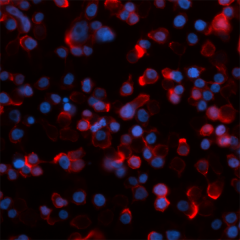
-

Human acute myeloid leukemia cell line (KG1) cells were fixed with 2% paraformaldehyde (PFA) and blocked for 30 minutes with 5% FBS. Then the cells were stained with 5 µg/ml of Alexa Fluor® 594 anti-human CD325 (N-Cadherin) (clone 8C11) (red) at room temperature for two hours. Nuclei were counterstained with DAPI (blue). The image was captured with a 40X objective.
| Cat # | Size | Price | Quantity Check Availability | ||
|---|---|---|---|---|---|
| 350816 | 100 µg | $323.00 | |||
CD325 (N-cadherin) is a 130 kD, single pass transmembrane protein. Its extracellular region consists of five EC domains and has one cytoplasmic domain. N-cadherin is involved in organogenesis and maintenance of organ architecture by contributing to the sorting of heterogeneous cell types and in the cell adhesion needed to form tissues. N-cadherin is expressed by stem cells, myeloblasts, endothelial cells, and fibroblasts, and also is expressed in neural and muscle tissues and some types of carcinoma cells. CD325 associates with the cytoskeleton trough catenin proteins.
Product Details
- Verified Reactivity
- Human
- Antibody Type
- Monoclonal
- Host Species
- Mouse
- Immunogen
- Recombinant human N-cadherin extracellular domain
- Formulation
- Phosphate-buffered solution, pH 7.2, containing 0.09% sodium azide.
- Preparation
- The antibody was purified by affinity chromatography and conjugated with Alexa Fluor® 594 under optimal conditions.
- Concentration
- 0.5 mg/ml
- Storage & Handling
- The antibody solution should be stored undiluted between 2°C and 8°C, and protected from prolonged exposure to light. Do not freeze.
- Application
-
ICC - Quality tested
- Recommended Usage
-
Each lot of this antibody is quality control tested by immunocytochemistry. For immunocytochemistry, a concentration range of 2.5 - 10 μg/ml is recommended. It is recommended that the reagent be titrated for optimal performance for each application.
* Alexa Fluor® 594 has an excitation maximum of 590 nm, and a maximum emission of 617 nm.
Alexa Fluor® and Pacific Blue™ are trademarks of Life Technologies Corporation.
View full statement regarding label licenses - Application Notes
-
The mAb 8C11 recognizes the amino acids 92–593 of CD325, located between the extracellular cadherin structural domain (EC) 3 and 4. Additional reported applications (for the relevant formats) include: immunofluorescence1,3,6, motility inhibition of N-cadherin-expressing cells2, and Western blot2,4.
-
Application References
(PubMed link indicates BioLegend citation) -
- Navarro P, et al. 1998. J. Cell Biol. 140:1475. (IF)
- Kim JB. 2000. J. Cell Biol. 151:1193. (Block, WB)
- Puch S, et al. 2001. J. Cell. Sci. 114:1567. (IF)
- Wahl JK. 3rd, et al. 2003. J. Biol. Chem. 278:17269. (WB)
- Wein F, et al. 2010. Stem. Cell Res. 4:129. (FC)
- Jaggi M, et al. 2002. Cell. Commun. Adhes. 9:103. (IF)
- Product Citations
-
- RRID
-
AB_2563226 (BioLegend Cat. No. 350816)
Antigen Details
- Structure
- Member of cadherin family, Single pass transmembrane protein, extracellular region consist of five EC domains, one cytoplasmic domain, 130 kD
- Distribution
-
Stem cells, myeloblasts, endothelial cells, fibroblasts, neural and muscle tissues, some types of carcinoma cells
- Function
- Embryonic development, maintain tissue architecture, cell sorting and cell adhesion in tissues, promote motility
- Interaction
- Catenins
- Cell Type
- Endothelial cells, Fibroblasts, Hematopoietic stem and progenitors, Mesenchymal Stem Cells, Neural Stem Cells
- Biology Area
- Cell Adhesion, Cell Biology, Cell Motility/Cytoskeleton/Structure, Immunology, Neuroscience, Neuroscience Cell Markers, Stem Cells, Synaptic Biology
- Molecular Family
- Adhesion Molecules, CD Molecules
- Antigen References
-
1. Colomiere M, et al. 2009. Brit. J. Cancer 100:134.
2. Yan W, et al. 2010. J. Biol. Chem. 285:14042.
3. Mosnier JF, et al. 2009. Mod. Pathol. 22:182.
4. Gao L, et al. 2010. Stem Cells 28:564. - Gene ID
- 1000 View all products for this Gene ID
- UniProt
- View information about CD325 on UniProt.org
Other Formats
View All CD325 Reagents Request Custom Conjugation| Description | Clone | Applications |
|---|---|---|
| PE anti-human CD325 (N-Cadherin) | 8C11 | FC |
| Purified anti-human CD325 (N-Cadherin) | 8C11 | FC,ICC,WB,Block |
| APC anti-human CD325 (N-Cadherin) | 8C11 | FC |
| Alexa Fluor® 488 anti-human CD325 (N-Cadherin) | 8C11 | FC |
| PE/Cyanine7 anti-human CD325 (N-Cadherin) | 8C11 | FC |
| PerCP/Cyanine5.5 anti-human CD325 (N-Cadherin) | 8C11 | FC |
| Alexa Fluor® 594 anti-human CD325 (N-Cadherin) | 8C11 | ICC |
| TotalSeq™-A0433 anti-human CD325 (N-Cadherin) | 8C11 | PG |
| TotalSeq™-C0433 anti-human CD325 (N-Cadherin) | 8C11 | PG |
| TotalSeq™-D0433 anti-human CD325 (N-Cadherin) | 8C11 | PG |
| TotalSeq™-B0433 anti-human CD325 (N-Cadherin) | 8C11 | PG |
Compare Data Across All Formats
This data display is provided for general comparisons between formats.
Your actual data may vary due to variations in samples, target cells, instruments and their settings, staining conditions, and other factors.
If you need assistance with selecting the best format contact our expert technical support team.
-
PE anti-human CD325 (N-Cadherin)
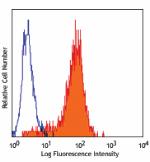
Human acute myeloid leukemia cell line (KG1) were stained wi... -
Purified anti-human CD325 (N-Cadherin)

Human acute myeloid leukemia cell line (KG1) stained with CD... 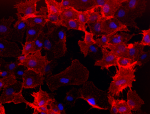
HUVEC cells were fixed with 1% paraformaldehyde (PFA) and th... -
APC anti-human CD325 (N-Cadherin)
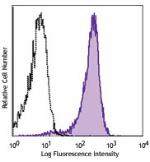
Human acute myeloid leukemia cell line (KG1) was stained wit... -
Alexa Fluor® 488 anti-human CD325 (N-Cadherin)
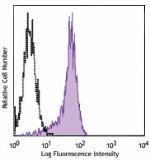
Human acute myeloid leukemia cell line (KG1a) was stained wi... -
PE/Cyanine7 anti-human CD325 (N-Cadherin)
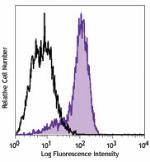
Human acute myeloid leukemia cell line (KG1a) was stained wi... -
PerCP/Cyanine5.5 anti-human CD325 (N-Cadherin)
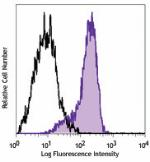
Human acute myeloid leukemia cell line (KG1a) was stained wi... -
Alexa Fluor® 594 anti-human CD325 (N-Cadherin)
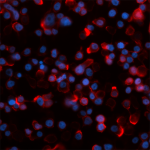
Human acute myeloid leukemia cell line (KG1) cells were fixe... -
TotalSeq™-A0433 anti-human CD325 (N-Cadherin)
-
TotalSeq™-C0433 anti-human CD325 (N-Cadherin)
-
TotalSeq™-D0433 anti-human CD325 (N-Cadherin)
-
TotalSeq™-B0433 anti-human CD325 (N-Cadherin)
